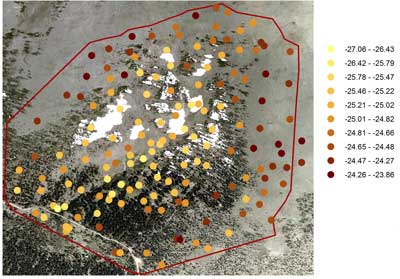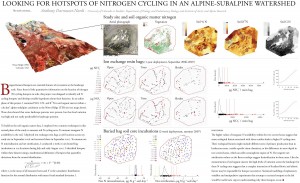Front Range Student Ecology Symposium
February 26, 2009 – 1:31 pmI had a great time yesterday presenting at the Front Range Student Ecology Symposium at CSU Fort Collins. It was an impressively well organized conference and I had a lot of really nice conversations with CSU grad students and others about my poster, which is here:
This poster was a continuation of a previous poster I made a couple years ago. Together, they summarize most of my findings on hotspots of N cycling on Niwot Ridge, which are admittedly a little meager, but for better or worse, there they are!
I also saw a cool presentation by one of the conference organizers, Aaron Berdanier, in which he talked about understanding water limitation in the alpine. I met Aaron last summer when he was working on Niwot Ridge. His idea was to try to figure out whether water limitation of plants was being caused by direct impacts on stomatal conductance or by indirect impacts on microbial nutrient mineralization.
Both of these things could be occurring at different times and it would be neat to try to separate them in field experiments. Aaron presented some nice data on δ13C of Polygonum vivipara, a common alpine forb, showing that their carbon isotopes didn’t vary much in different moisture conditions. This is pretty interesting, since it is somewhat contradictory to a map I made of soil carbon isotopes in alpine and subalpine meadows in which soil δ13C correlates fairly well with moisture regimes across the landscape.

There are many things that could be going on here and it would be cool to figure it all out.

4 Responses to “Front Range Student Ecology Symposium”
Last night I was reading more about this trying to see if anyone has looked at the links between plant and soil C isotopes. In a book called “Mass Spectrometry of Soils” the authors noted that δ13C doesn’t change MUCH during the first few years of decomposition, but that there is fractionation as the microbes assimilate the carbon. They suggested that microbes preferentially respire lighter carbon, which causes soil organic carbon to be slightly more enriched (around 1-3‰).
Is it enough to account for the differences that you saw on the landscape, especially with the (generally) slower decomposition in high-elevations? I guess that awaits to be seen.
Another thing I thought about is the turnover time of carbon in the soil. Could there be an additive effect of enriching the soil in the dry sites (from slight enrichment every year) over many years? Do you know any general turnover times for soil carbon?
By Aaron on Feb 26, 2009
When I measured these samples, I measured two density fractions that varied in average residence time: one lighter fraction with a turnover time of about a decade, and one heavier fraction with a turnover time of decades to centuries. I just took a look at these two fractions and the patterns look basically the same as the total pattern that I posted.
In particular, the fact that the light fraction – which is thought to be chemically dominated by plant materials – shows the same correlation with landscape moisture regimes suggests that plant inputs are exerting a fairly strong influence on the soil δ13C signature. However, this does not rule out the decomposition effect that you mention.
As for the slow enriching effect over time, the data from the two density fractions do suggest that a small amount of this is occurring. The difference in mean δ13C between the two fractions is about 0.8‰.
It would be great to see how these soil values compare to fresh plant material from these areas and how fresh material from different plant species compare to each other.
By Anthony on Feb 26, 2009
Good information, Anthony. I think that the soil has great potential to give a really good index of the plant response to average environmental conditions, especially in the light fraction. Thanks!
By Aaron on Feb 27, 2009